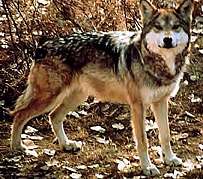The Mexican gray wolf (Canis lupus baileyi), also called the “Mexican wolf” or “lobo,” is the southern-most occurring subspecies of the gray wolf in North America. The Mexican Gray Wolf is the most endangered wolf species in North America.
Mexican gray wolf:Canis lupus baileyi
Mexican wolves typically weigh 60 to 80 pounds and measure about 5 1/2 feet from nose to tail (about the size of an adult German shepherd). They have a distinctive, richly colored coat of buff, gray, rust and black.
Like other wolves, Mexican wolves have a complex social structure and live in extended family groups, consisting of an adult mated pair and their offspring. Wolves hunt cooperatively to bring down prey animals usually much larger than themselves. Native prey for Mexican wolves includes white-tailed deer, mule deer and elk.
The U.S. Fish and Wildlife Service, in cooperation with the Arizona Game and Fish Department, the New Mexico Department of Game and Fish, USDA Wildlife Services and USDA Forest Service, began releasing captive-reared Mexican wolves into the designated “primary recovery zone” in the Apache National Forest in eastern Arizona.
Released wolves and their progeny have been designated a nonessential experimental population under a special provision of the Endangered Species Act. These wolves are allowed to disperse into and colonize the entire Apache National Forest and adjacent Gila National Forest in western New Mexico – an area of about 7,000 square miles.

MEXICAN WOLF STATUS:
Endangered.
MEXICAN WOLF DESCRIPTION:
Mexican wolves are the smallest subspecies of North American gray wolves. They are also the most endangered. Commonly referred to as “El lobo,” the Mexican wolf is gray with light brown fur on its back. It has long legs and a sleek body to help it run fast.
MEXICAN WOLF SIZE:
An adult Mexican wolf typically weighs 60 to 80 pounds, measures 26 to 32 inches tall from the shoulder and ranges from four-and-a-half to five-and-a-half feet long.
MEXICAN WOLF POPULATION:
Once extirpated from the southwestern United States, 34 wolves returned to southeastern Arizona following a reintroduction program begun in March, 1998. During the first year of reintroduction, five were shot, one was hit by a vehicle, one disappeared and five others were returned to captivity. There are only about 200 Mexican wolves in captivity. Releases will continue through 2002. The goal of the reintroduction program is to restore at least 100 wolves to the wild by 2008.
MEXICAN WOLVES LIFESPAN:
Mexican wolves are known to reach 15 years of age in captivity.
MEXICAN WOLF RANGE:
 Once ranging from central Mexico to southwestern Texas, southern New Mexico and southeastern Arizona, today the Mexican wolf has been reintroduced to the Apache National Forest in southeastern Arizona and may move into the adjacent Gila National Forest in western New Mexico as the population expands.
Once ranging from central Mexico to southwestern Texas, southern New Mexico and southeastern Arizona, today the Mexican wolf has been reintroduced to the Apache National Forest in southeastern Arizona and may move into the adjacent Gila National Forest in western New Mexico as the population expands.
MEXICAN WOLF HABITAT:
Mexican wolves prefer to live in mountain forests, grasslands and shrublands.
MEXICAN WOLVES DIET:
Mexican wolves prey on white-tailed deer, mule deer and elk but are also known to eat smaller mammals such as rabbits, ground squirrels and mice.
MEXICAN WOLF BEHAVIOR:
Wolves are very social animals. They live in packs, which are complex social structures that include the breeding adult pair (the alpha male and female) and their offspring. A hierarchy of dominant and subordinate animals within the pack help it to work as a unit.
MEXICAN WOLF BREEDING HABITS:
 Wolves mate between mid-February and mid-March. Gestation is roughly two months long, and wolf pups are born in April or May. Two to eight pups are born every year. The average litter is between four and seven pups.
Wolves mate between mid-February and mid-March. Gestation is roughly two months long, and wolf pups are born in April or May. Two to eight pups are born every year. The average litter is between four and seven pups.
THREATS TO MEXICAN WOLVES:
Humans and habitat destruction are the only major threats to wolves.
MEXICAN WOLF PROTECTION:
Endangered Species Act, *CITES, Appendix I
*Convention on International Trade in Endangered Species of Wild Fauna and Flora, an international treaty with more than 144 member countries. Appendix I listed species cannot be traded commercially. Appendix II listed species can be traded commercially only if it does not harm their survival.

